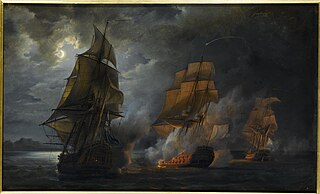Numerous British vessels have borne the name Prince of Wales, after the then current Prince of Wales, the title borne by the heir-presumptive to the throne of the United Kingdom.

HMS Babet was a 20-gun sixth-rate post ship of the British Royal Navy. She had previously been a corvette of the French Navy under the name Babet, until her capture in 1794, during the French Revolutionary Wars. She served with the British, capturing several privateers and other vessels, and was at the Battle of Groix. She disappeared in the Caribbean in 1801, presumably having foundered.

Pégase was a 74-gun ship of the line of the French Navy, lead ship of her class, launched in 1781.
Ten ships of the Royal Navy have borne the name HMS Blanche:
Eight ships of the Royal Navy have borne the name HMS Dover, after the English town and seaport of Dover:

Aréthuse, launched in April 1798, was the name-ship of the eponymous Aréthuse-class corvettes of the French Navy. Excellent captured her in 1799. The Royal Navy took her into service under the name HMS Raven. She was wrecked in 1804.
Many vessels have been named Minerva for the mythological figure Minerva:

HMS Jupiter was a 50-gun Portland-class fourth-rate ship of the Royal Navy. She served during the American War of Independence, the French Revolutionary Wars, and the Napoleonic Wars in a career that spanned thirty years. She was also one of the fastest ships in the Royal Navy as shown by her attempt to capture the cutter Eclipse under Nathaniel Fanning.

HMS Arrow was a sloop-of-war in the Royal Navy that the Admiralty purchased in 1796. during the French Revolutionary Wars she participated in many actions, including one that resulted in her crew qualifying for the Naval General Service Medal. On 3 February 1805 she and Acheron were escorting a convoy from Malta to England when they encountered two French frigates. Arrow and Acheron were able to save the majority of the vessels of the convoy by their resistance before they were compelled to strike. Arrow sank almost immediately after surrendering, and Acheron was so badly damaged that the French burnt her.
Several French ships have borne the name Courageux, Courageaux, or Courageuse:
Numerous French naval vessels have borne the name Résolue, the French for "Resolute", as have several privateers.

Four vessels with the name Princess Royal have served the British East India Company (EIC).

HMS Acheron was the mercantile New Grove, launched at Whitby in 1799, that the Admiralty purchased in 1803 and fitted as a bomb-vessel. She served in the Mediterranean for about a year. On 3 February 1805 she and Arrow were escorting a convoy from Malta to England when they encountered two French frigates. Arrow and Acheron were able to save the majority of the vessels of the convoy by their resistance before they were compelled to strike. Arrow sank almost immediately after surrendering, and Acheron was so badly damaged that the French burnt her. However, the British vessels' self- sacrifice enabled almost all the vessels of the convoy to escape.
A number of sailing ships have been named Queen Charlotte.
Canada was launched at King's Yard in 1779 for the Royal Navy, which sold her at the end of the war. Unfortunately, her name while in Royal Navy service is currently unknown. John St Barbe purchased her and named her Adriatic, but renamed her Canada c.1786. She made three seal hunting and whaling voyages between 1791 and 1799 under that name, and was lost at South Georgia in 1800 on her fourth.
Duchess of York was a vessel probably launched in 1790. She served the Royal Navy as a hired armed cutter between 1795 and 1800. From 1801 she was a merchantman, sailing primarily between Dover and Exmouth. She is last listed in 1808.
Several ships have been named Commerce:
Several vessels have been named Nile ether for the Battle of the Nile, or for the Nile river:
Duchess of Rutland was launched in Sweden in 1786 under another name. She was taken in prize in 1799 and thereafter served as a transport. French frigates captured and burnt her on 4 February 1805 as she was sailing in convoy from Malta to London.
Duchess of Rutland was launched in 1786 in Dublin. She carried passengers between England and Ireland. In 1793 she apparently transferred to Liverpool and sailed from there as a West Indiaman. She was on a voyage to Barbados when a French privateer captured her in 1797.
This page is based on this
Wikipedia article Text is available under the
CC BY-SA 4.0 license; additional terms may apply.
Images, videos and audio are available under their respective licenses.





